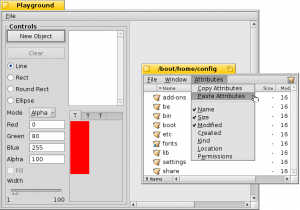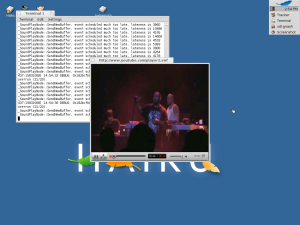
|
|||||||||||||||||
|
As read here on the Haiku Gazette work has been done on renewing a bit the GUI appearence. After some evolving discussions in the forums (here and there) Denis Washington started work on the rendering code to make our UI look better as proposed in forum’s mockups. He now have a diff patch (which is still work in progress) but once applied it changes Haiku look to something like this: More information about the patch and how it evolves in this forum thread. Wanna see a before / after comparison ? Head over here.
As read in HaikuWare this morning I was very excited learning that we now have Flash running under Haiku ! Adrian Panasiuk which took the Flash bounty has completed a prototype (still statically linked) based on Gnash proving that we are not that far from having a integrated product. One shadow tough: “many youtube videos don’t work with gnash also on linux“… Anyway: Big Big Kudos in getting us as far as the Linux guys :-) ! More detail @ Haikuware.
Over the last few weeks, I’ve been working on a few tweaks to the All Comments page (first introduced back in January). The most visible change is that users can now create new discussion threads, making it behave a bit more like a normal forum – simply click the “Post a new Topic” link on the All Comments page. At present, you have to be registered and logged-in before you can start a new discussion – which was done partly because it was easier, and partly to prevent it from becoming a gateway for spam (there have been close to 36,000 spam comments posted here, although filters have caught most of them). Replies can still be posted without logging-in, however. Discussions / threads created by users are shown on the All Comments page, with a slightly different colour to distinguish them from comments on frontpage posts. I’ve put together a short introductory post with a few more details. If you have any feedback, suggestions, or if you spot any bugs (highly likely), please let me know in the comments.
According to an announcement made on HaikuWare back on Valentine’s day, a developer by the name of Adrian Panasiuk has taken up the challenge of porting Gnash (an open-source Flash player) to Haiku. From the announcement:
While the completion date does sound a bit optimistic, it’s still very encouraging to find out that there is active development to get Flash working in Haiku. Whether you love it or loathe it, the simple reality is that Flash has become a de facto standard for online video delivery.
Remember this news ? Back in June ’08 has Oliver Ruiz Dorantes announced he got from Bernd Korz (the Yellowtab man) the right to use source code of Whisper VoIP application. Friday Oliver posted an status update on that project telling us that Whisper is now (since december in fact) running on Haiku. Interrestingly he used 0033’s Niue as build system for ZETA, and DarkWyrm’s Paladin for build system for Haiku. More information and a nice screenshot available at Oliver’s blog page.
Nope, it’s not the latest Jimmy Dean product – it’s new piece of software that simplifies the process of installing Haiku to a USB device. Created by Fredrik Modeen, the concept is simple but quite clever: it’s a small Windows application that will download the latest Haiku disk image and copy the contents to a USB device that the user chooses. While it’s always been simple to install Haiku from within BeOS, the process can be much more daunting for those who don’t currently use BeOS – and running Haiku in a virtual machine is much slower than using it on real hardware. Haiku on a Stick should allow many potential Haiku users to try it out on real hardware. Update: in the comments for this post, reader “Leszek” pointed out that there is an equivalent application for Linux called “Haiku-DD” (created by the same developers behind the ZevenOS project).
Over on Haikuware there is an interview with Christof Lutteroth – one of the developers behind two Haiku-based projects that we’ve reported on recently: the user-editable GUI prototype, using the Aukland Layout Model, and the “Stack & Tile” window management prototype. The interview with Christof (who lectures on software engineering at the University of Auckland) provides some interesting background details on those two projects, especially Stack & Tile:
It’s fantastic to hear that Haiku has progressed to the point where it’s receiving contributions from academia – and, beyond that, being used as a teaching tool for software engineering. Thanks go to Karl vom Dorff for the excellent interview.
|
|||||||||||||||||
|
|
|||||||||||||||||

